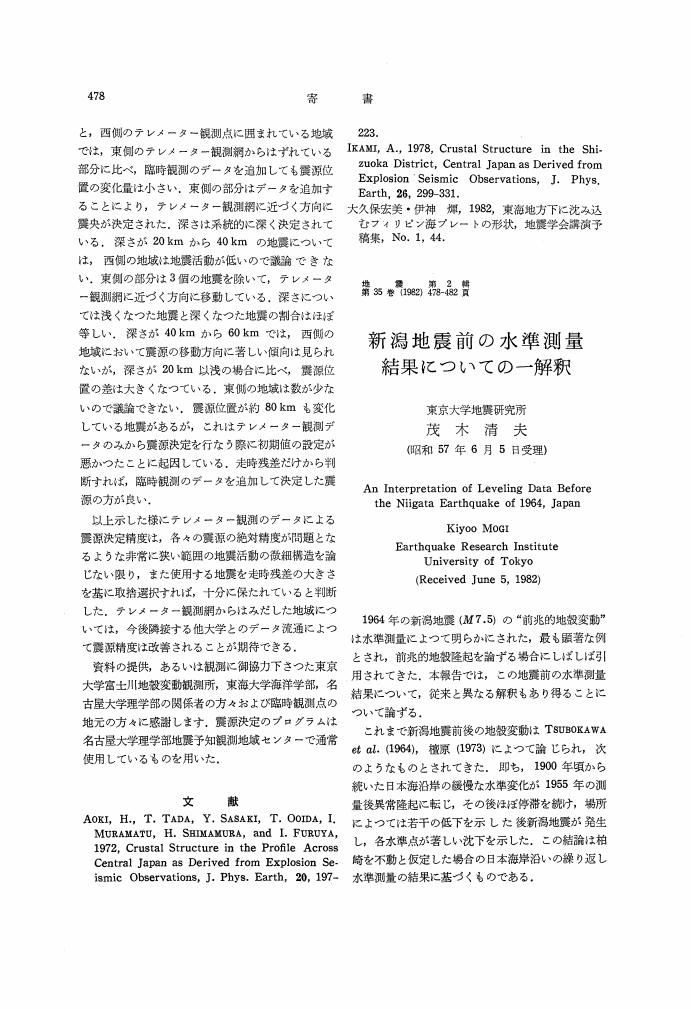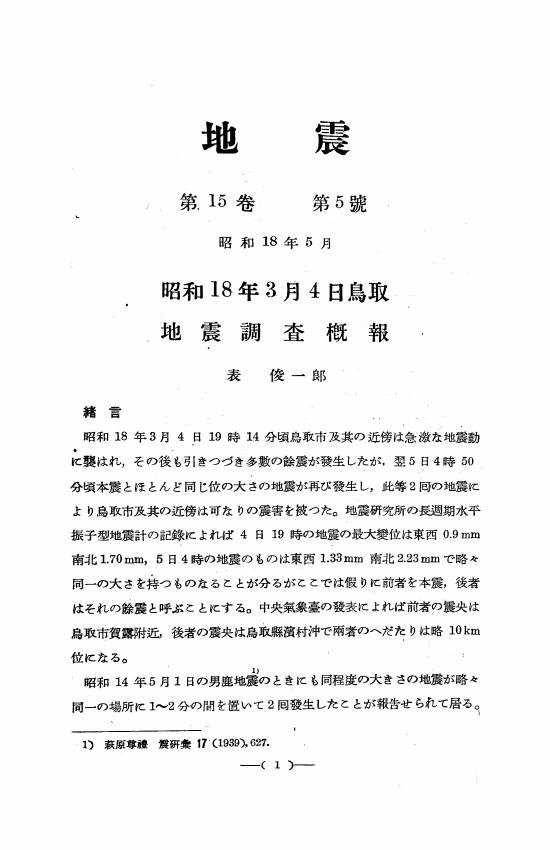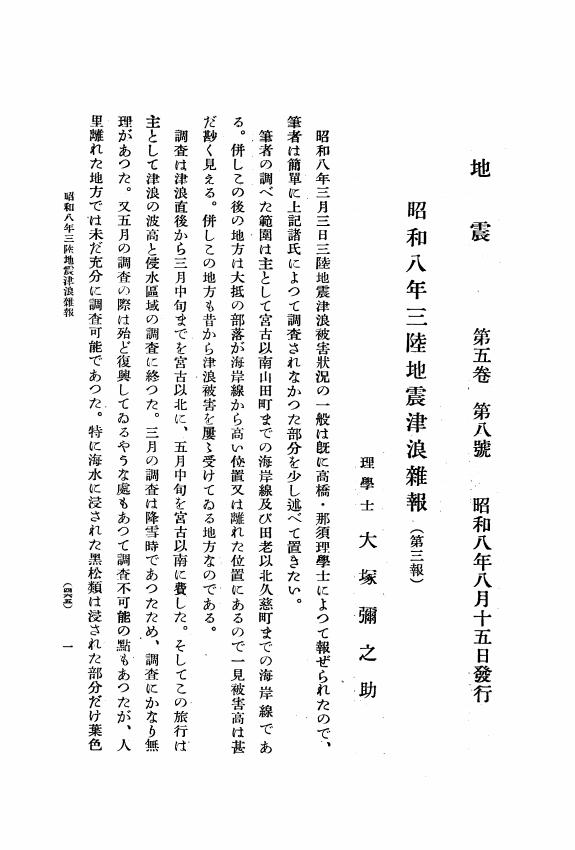1 0 0 0 OA 関東地方下のフィリピン海プレート内地震の発生機構
- 著者
- 堀 貞喜
- 出版者
- 公益社団法人 日本地震学会
- 雑誌
- 地震 第2輯 (ISSN:00371114)
- 巻号頁・発行日
- vol.50, no.2, pp.203-213, 1997-08-28 (Released:2010-03-09)
- 参考文献数
- 36
- 被引用文献数
- 2
The upper mantle earthquakes occurring within the Philippine Sea plate subducting beneath the Kanto district, Japan, were investigated for their hypocentral distribution and focal mechanisms. Earthquakes located above the double seismic plane, which is formed in conjunction with the subducting motion of the Pacific plate, were picked up on a graphic display with an “on-map selection” method. Hypocentral parameters were re-determined with removing stations far from the epicenter and with introducing station corrections to the observed arrival time data. Based on the relocated hypocenters, the focal mechanism solutions were also re-determined. Examining the hypocentral distribution in detail, we found that the earthquakes occurring within the Philippine Sea plate are classified into three groups and that their focal regions form a triple-layered structure. The earthquakes in Group I, which are located at the uppermost part of the slab, were found to occur in the oceanic crust of the Philippine Sea plate from their waveform analysis. The focal mechanism analysis showed remarkable difference between the earthquakes in Groups II and III. The down-dip compression type events are predominant for the earthquakes in Group II, while most of the focal mechanisms in Group III showed the earthquakes are occurring under the down-dip extension. We proposed a model to explain the earthquake mechanism within the Philippine Sea plate, where the “forced unbending” by the underlying Pacific plate causes compressional and extensional stress fields in the upper and lower portion of the slab, respectively.
1 0 0 0 OA 新潟地震前の水準測量結果についての一解釈
- 著者
- 茂木 清夫
- 出版者
- 公益社団法人 日本地震学会
- 雑誌
- 地震 第2輯 (ISSN:00371114)
- 巻号頁・発行日
- vol.35, no.3, pp.478-482, 1982-09-25 (Released:2010-03-11)
- 参考文献数
- 5
1 0 0 0 OA 1948年福井地震に関する文献目録
- 著者
- 小嶋 啓介 荒井 克彦
- 出版者
- 公益社団法人 日本地震学会
- 雑誌
- 地震 第2輯 (ISSN:00371114)
- 巻号頁・発行日
- vol.52, no.1, pp.213-218, 1999-06-30 (Released:2010-03-11)
- 参考文献数
- 116
1 0 0 0 OA 天明の小田原地震 (1782-VIII-23) について
1 0 0 0 OA 昭和18年3月4日鳥取地震調査概報
- 著者
- 表 俊一郎
- 出版者
- 公益社団法人 日本地震学会
- 雑誌
- 地震 第1輯 (ISSN:00371114)
- 巻号頁・発行日
- vol.15, no.5, pp.101-113, 1943-05-18 (Released:2010-11-17)
- 参考文献数
- 5
1 0 0 0 OA 地震及び火山噴火に關する思想の變遷
- 著者
- 今村 明恒
- 出版者
- 公益社団法人 日本地震学会
- 雑誌
- 地震 第1輯 (ISSN:00371114)
- 巻号頁・発行日
- vol.16, no.6, pp.135-140, 1944-06-18 (Released:2010-11-17)
1 0 0 0 OA 宮古島近海における固有地震活動
- 著者
- 溜渕 功史 山田 安之 石垣 祐三 高木 康伸 中村 雅基 前田 憲二 岡田 正実
- 出版者
- 公益社団法人 日本地震学会
- 雑誌
- 地震 第2輯 (ISSN:00371114)
- 巻号頁・発行日
- vol.62, no.4, pp.193-207, 2010-03-15 (Released:2012-03-26)
- 参考文献数
- 26
We found eight M 5.1 characteristic earthquakes regularly occurring since 1966 on the plate boundary between the Eurasian plate and the Philippine Sea plate near Miyakojima Island, the Ryukyu Arc, Japan. The quake recurrence interval was 5.89 years in average, and the standard deviation was only 0.73 years. The accumulating stress presumably ruptured the same asperity enclosed by the creeping zone repeatedly. Also, we found three other groups of small repeating earthquakes of M 4, which occurred close to the hypocenters of the M 5 events. Those groups also occurred regularly and we can consider them to be ‘characteristic’ earthquake sequences. Now, we called those groups A, B, and C. It is not clear whether groups A and B had an intrinsic recurrence interval or if they influenced each other. However, two events of group C occurred within one week after the M 5 quakes, indicating that the M 5 events triggered the group C events whose asperity had suffcient strain energy. No earthquake exceeding M 7, which could change the recurrence intervals, has been observed on the subduction zone around the Ryukyu Islands. Therefore, there should be numerous characteristic earthquake sequences in other areas of the Ryukyu district. We expect that the next M 5 earthquake at 50 km depth on the plate boundary near Miyakojima Island will occur between September 2012 and July 2014 with 70% probability, using the small-sample theory with a log-normal distribution model. Moreover, the M 5 event may be accompanied by an M 4 quake that could rupture the asperity of group C within one week.
1 0 0 0 OA 1935年7月11日静岡地震の発生機構
- 著者
- 武尾 実 阿部 勝征 辻 秀昭
- 出版者
- 公益社団法人 日本地震学会
- 雑誌
- 地震 第2輯 (ISSN:00371114)
- 巻号頁・発行日
- vol.32, no.4, pp.423-434, 1979-12-25 (Released:2010-03-11)
- 参考文献数
- 33
- 被引用文献数
- 1 3
The source parameters of the Shizuoka earthquake (M=6.3) of July 11, 1935, are determined mainly on the basis of the close-in long-period seismograms. The epicenter and focal depth are redetermined at 35.0°N, 138.4°E and 27km. This earthquake represents a left-lateral strike-slip faulting on a plane dipping 70° toward 15°SE with a dimension of 11km(length)×6km(width). The average dislocation, rise time and stress drop are determined to be 1m, 1sec and 70 bars, respectively. The faulting at the depth of about 20km is very rare in Japan; because most of the major strike-slip events in Japan occurred near the ground surface. The theoretical ground motions expected from the above dislocation parameters are consistent with the leveling data and with the field data on the collapsed structures in the epicentral area.
1 0 0 0 OA 明治の東京地震 (1894年) の震源パラメーターについて
- 著者
- 勝間田 明男 橋田 俊彦 三上 直也
- 出版者
- 公益社団法人 日本地震学会
- 雑誌
- 地震 第2輯 (ISSN:00371114)
- 巻号頁・発行日
- vol.52, no.1, pp.81-89, 1999-06-30 (Released:2010-03-11)
- 参考文献数
- 32
- 被引用文献数
- 2
Old seismograms of the Tokyo earthquake in the Meiji era (June 20, 1894) were analyzed to retrieve source parameters. This earthquake gave considerable damage on the Tokyo metropolitan area. The focal depth was estimated to be about 50km or about 80km from S-P times of several seismograms observed at Tokyo. The magnitude, which was calculated from data of maximum amplitudes, was 6.6. The focal mechanism and the seismic moment were inferred from waveform fitting with seismograms observed by a Ewing-type strong motion seismograph and a Gray-Milne-Ewing-type seismograph. The estimated moment is 1-3×1018Nm (Mw=6.0-6.3). The earthquake is considered to have a nearly vertical nodal plane with N-S strike, and to have occurred in the Pacific plate or the Philippine Sea plate. Stress drop of the event was larger than the average value in the region.
1 0 0 0 OA 甲府盆地における1854年と1923年の地震被害のテクトニックな意義
- 著者
- 石橋 克彦
- 出版者
- 公益社団法人 日本地震学会
- 雑誌
- 地震 第2輯 (ISSN:00371114)
- 巻号頁・発行日
- vol.36, no.4, pp.668-671, 1983-12-25 (Released:2010-03-11)
- 参考文献数
- 17
- 被引用文献数
- 2
1 0 0 0 OA 今村式2倍強震計の構造図
- 著者
- 田中 貞二 横田 治彦 岩田 孝行
- 出版者
- 公益社団法人 日本地震学会
- 雑誌
- 地震 第2輯 (ISSN:00371114)
- 巻号頁・発行日
- vol.41, no.2, pp.283-285, 1988-06-25 (Released:2010-03-11)
- 参考文献数
- 5
- 被引用文献数
- 3
1 0 0 0 OA 三陸地震津浪雑報(第二報)
- 著者
- 那須 信治
- 出版者
- 公益社団法人 日本地震学会
- 雑誌
- 地震 第1輯 (ISSN:00371114)
- 巻号頁・発行日
- vol.5, no.6, pp.341-351, 1933-06-15 (Released:2010-11-17)
1 0 0 0 OA 昭和八年三陸地震津浪雑報(第一報)
- 著者
- 那須 信治 高橋 龍太郎
- 出版者
- 公益社団法人 日本地震学会
- 雑誌
- 地震 第1輯 (ISSN:00371114)
- 巻号頁・発行日
- vol.5, no.4, pp.202-261, 1933-04-15 (Released:2010-11-17)
1 0 0 0 OA 昭和八年三陸地震津浪雜報(第三報)
- 著者
- 大塚 彌之助
- 出版者
- 公益社団法人 日本地震学会
- 雑誌
- 地震 第1輯 (ISSN:00371114)
- 巻号頁・発行日
- vol.5, no.8, pp.465-496, 1933-08-15 (Released:2010-11-17)
1 0 0 0 OA 日本に於ける過去の地震活動に就いて (未定稿)
- 著者
- 今村 明恒
- 出版者
- 公益社団法人 日本地震学会
- 雑誌
- 地震 第1輯 (ISSN:00371114)
- 巻号頁・発行日
- vol.8, no.3, pp.121-134, 1936-03-15 (Released:2010-03-09)
1 0 0 0 OA 昭和6年2月20日日本海北部の地震の調査 (第一報)
- 著者
- 河角 廣 吉山 良一
- 出版者
- 公益社団法人 日本地震学会
- 雑誌
- 地震 第1輯 (ISSN:00371114)
- 巻号頁・発行日
- vol.6, no.8, pp.415-442, 1934-08-15 (Released:2010-07-27)
- 参考文献数
- 27
1 0 0 0 OA 地震動と地震記象補遺
- 著者
- 河角 廣
- 出版者
- 公益社団法人 日本地震学会
- 雑誌
- 地震 第1輯 (ISSN:00371114)
- 巻号頁・発行日
- vol.4, no.3, pp.167-169, 1932-03-15 (Released:2010-11-17)
1 0 0 0 OA 標準用語制定に就て
- 著者
- 河角 廣
- 出版者
- 公益社団法人 日本地震学会
- 雑誌
- 地震 第1輯 (ISSN:00371114)
- 巻号頁・発行日
- vol.16, no.2, pp.29-32, 1944-02-18 (Released:2010-11-17)
1 0 0 0 OA 低圧高温型変成帯のダイナミクスと熱源モデル
- 著者
- 竹下 徹 奥平 敬元
- 出版者
- 公益社団法人 日本地震学会
- 雑誌
- 地震 第2輯 (ISSN:00371114)
- 巻号頁・発行日
- vol.47, no.4, pp.453-467, 1995-01-24 (Released:2010-03-11)
- 参考文献数
- 79
- 被引用文献数
- 1
Dynamics and thermal modeling in low-pressure/high-temperature metamorphic belts (LPMs) are reviewed. LPM found in the world is formed under such P-T conditions that the pressure is lower than that of the aluminosilicate (Al2SiO5) triple point (about 400MPa), and the peak temperature ranges between 500 and 700°C. Such anomalously high temperatures at relatively shallow depth indicate that the geothermal gradient in the upper crust exceeded 50°C km-1 at the time of LPM formation. Although the steady state geothermal gradients in the upper crust necessary for the formation of LPM could be reached by continuously supplying a huge amount of magma in the upper crust [OXBURGH and TURCOTTE (1971)], such a steady state model is unlikely because of no observation of entire melting of the lower crust which is the outcome of the steady state model. Rather, transient heat sources such as the intrusion of magma, circulation of hot fluid, subduction of young oceanic plate or spreading ridge and convective thinning of the mantle lithosphere have been proposed to be the possible heat sources for LPM. Based on the heat transfer calculations, the duration of high-temperature condition by the intrusion of magma which is several kilometer wide, is less than 1Ma, and that by the circulation of hot fluid is poorly constrained. Even in the thermal model where the highest-temperatures in the country rocks attained by the intrusion of magma are assumed to be recorded as the metamorphic temperatures, the volume of magma necessary for the formation of LPM is more than 50% of the total volume of the crust [HANSON and BARTON (1989)]. Among these thermal models of LPM, subduction of young oceanic plate or spreading ridge is a likely model of LPM, not only because there are many occurrences of LPM evolved from accretionary sedimentary piles at trench, but because the ridge subduction can cause volcanism in the forearc [e. g., DELONG et al. (1979)] in addition to the anomalous heat supply to sediments from the asthenosphere. In order to further constrain the dynamics and thermal model of LPM in future, the P-T path and the duration of low-pressure type metamorphism must be accurately estimated petrologically, and the relative timing between metamorphism and deformation must be thoroughly investigated.
1 0 0 0 OA 改訂日本およびその周辺の津波の表
- 著者
- 渡辺 偉夫
- 出版者
- 公益社団法人 日本地震学会
- 雑誌
- 地震 第2輯 (ISSN:00371114)
- 巻号頁・発行日
- vol.36, no.1, pp.83-107, 1983-03-25 (Released:2010-03-11)
- 参考文献数
- 63
- 被引用文献数
- 2














